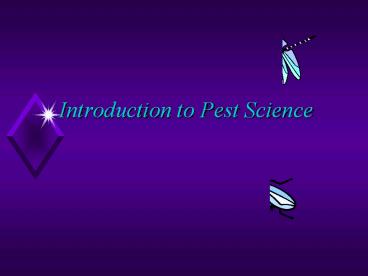Introduction to Pest Science - PowerPoint PPT Presentation
1 / 7
Title:
Introduction to Pest Science
Description:
Introduction to Pest Science Pests Interact with humans when they are finding food, fiber, shelter or space Can be vectors for disease Associated with all components ... – PowerPoint PPT presentation
Number of Views:68
Avg rating:3.0/5.0
Title: Introduction to Pest Science
1
Introduction to Pest Science
2
Pests
- Interact with humans when they are finding food,
fiber, shelter or space - Can be vectors for disease
- Associated with all components of society
- The whole biological spectrum is represented by
pests
3
Pests Cont
- Entire biological spectrum represented
- Proper identification is essential, without it
control is not possible - Staggering amount of time, energy, and money is
used to combat problems - Losses of food to our world food supply, is a
disastrous
4
Plant Pests - Invertebrates(animals without
backbones)
- Insects - 3 body parts
- Ticks, mites, spiders - 2 body parts and 8 legs
- Nematodes - unsegmented worms
- Snails Slugs - mollusks that prefer cool, moist
surroundings
5
Plant pests - Weeds(any plant growing out of
place)
- Adapt will to local climates and soils
- Compete with cultivated plants
- Produce large amounts of seeds
- Can remain dormant in soil for 20 years (seeds)
- Persistent and difficult to eradicate
6
Plant Pests - Weeds cont
- Compete with plants for water, nutrients, light
and space - Interfere with farming operations
- Harbor insect and plant diseases
- Can be toxic to livestock
- Identification can be done by colored pictures
7
Plant Pests - Disease
- Microscopic or Submicroscopic - difficult to
identify - Must be identified by symptoms present
- Bacteria, fungi and viruses are pathogens of
higher plants































